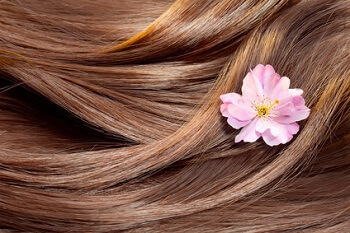Hair, like skin, fears the wind, the sun, pollution... So that the scales of your superb hair no longer rebel, delve into our file dedicated to the best vegetable oils for hair. By facing the wind, the cold, the sun, the water, the pollution, the hair dryer!!, the colorings, etc... our hair tends to become dull and dry out (the separation of the scales which make up the hair fiber being one of the major reasons). Our file will help you revitalize your hair by providing it with the necessary care to keep it in good health, synonymous with shine, volume and beauty!


Blend of vegetable oils to moisturize and nourish dry, dull hair
To deeply nourish damaged, dull or dry hair.
Mixes:
- 10 ml d'coconut oil
- 10 ml d'wheat germ oil
- 5 ml d'Castor oil
- 3 drops ofsandalwood essential oil
How to use it ?
Start by applying a small amount of vegetable oil (or a mixture of vegetable oils and essential oils) to the length and ends. Then gently massage the strands one by one to penetrate well and facilitate the sheathing and installation of the scales. Leave for 30 minutes to 1 hour under a warm towel. Then proceed with a gentle shampoo.
Oils to balance oily hair and regulate sebum production
Ideal for hair that tends to get greasy quickly. Also helps cleanse the scalp.
Mix:
- 10 ml d'Sesame oil
- 10 ml d'cry jojoba
- 10 ml d'nuts oil
- 10 drops oftea tree essential oil
- 10 drops oflavender essential oil
It's ready!
How to use it ?
Start by applying a small amount of vegetable oil (or a mixture of vegetable oils and essential oils) to the length and ends. Then gently massage the strands one by one to penetrate well and facilitate the sheathing and installation of the scales. Leave for 30 minutes to 1 hour under a warm towel. Then proceed with a gentle shampoo.
Vegetable oils to strengthen and give volume and shine to your hair
Ideal for all hair types. Strengthens the hair fiber and provides lots of reflections and shine.
- 10 ml d'Castor oil
- 10 ml d'coconut oil
- 10 ml d'cry jojoba
- 15 drops oflemon essential oil
How to use it ?
See the 2 recipes above
Vegetable oils to slow hair loss and promote growth:
A concentrate of active ingredients to stimulate growth and slow down hair loss!!!
- 10 ml d'Argan Oil
- 10 ml d'mustard oil
- 10 ml d'broccoli oil
- 10 ml d'sweet almond oil
- 5 drops ofbay of saint thomas essential oil
- 15 drops ofylang ylang essential oil
How to use it ?
See the 2 recipes aboveContraindications:
These synergies should not be used in pregnant women (during the entire pregnancy), breastfeeding women and children under 7 years old.
These properties and methods of use do not constitute medical advice. For therapeutic use consult a doctor.

The different types of hair: dry, oily or normal?
Hair is made up of 3 layers: the cuticle (i.e. the scales we have just talked about), the cortex (in a way the keratin vessels) and the medulla (present only in thick hair). When the cuticle is damaged or weakened (by various heat sources for example), the scales begin to peel off, the cortex and medulla are less protected, the hair loses its vitality and suppleness, it becomes dull and then brittle.
There are 3 types of hair: normal, dry and oily. At the base of each hair there is a so-called sebaceous gland. This gland produces the famous sebum whose purpose is to lubricate the hair to protect it. Hair type is directly linked to the amount of sebum produced:
- Normal hair: it is shiny, soft, light and easy to comb, sebum production is perfectly balanced to lubricate the hair without overly greasing or weighing it down.
- Oily hair: sebum production is too abundant. Hair gets dirty much faster, it is dull and sticky. Poor diet, stress, pollution or even too frequent washing are factors favoring the production of sebum and therefore the appearance of oily hair (there may also be a hereditary cause).
- Dry hair is brittle and fragile due to a lack of sebum. Dandruff usually appears on dry hair. Coloring, bleaching and the use of overly aggressive shampoos tend to dry out the hair.

How to distinguish healthy hair from damaged hair?
A few very simple signs should alert you. If you have difficulty combing your hair this is the first warning sign that something is wrong. Then split ends appear, then dry ends, dandruff and finally hair loss. It is then useful to treat the symptoms while looking for the cause (if the cause is not identified, it is very likely that the problem will return).
- If hair loss seems to be due to stress, add 2 drops of fine lavender essential oil to your dose of shampoo. In addition to toning and balancing the hair, lavender will provide you with its relaxing properties.
- Have an excellent lifestyle!! if your hair lacks vitamins, keratin and water it will not be well balanced... tip No. 1: drink 1.5 liters per day to preserve its health and the health of your hair. Vitamins A, B2, B5, B6, B8, B12 as well as foods rich in zinc, manganese and green tea should be favored.
With age, the entire metabolism slows down. Skin and hair may become drier. On a daily basis we often pay more attention to the skin than to the hair, but beautiful hair also means preserving youth. A few courses of vitamin complexes + more frequent hair masks should bring you visible results very quickly.
Take care of your hair naturally with vegetable oils?
First of all, it is essential to avoid hair products containing alcohol or alcohol derivatives. These will dry out your hair (read the labels carefully). Also avoid chemical and synthetic products such as silicones if possible (unfortunately there are a lot of them). They only give you a very superficial, short-term treatment and the health of your hair becomes completely artificial (it's exactly like hiding the dust under the carpet).
For decades, women around the world have been treating their hair with vegetable oils. Many oils containing natural active ingredients are particularly suited to hair health, nourishing them in depth and providing the balance necessary for their beauty: jojoba, shea, argan, broccoli, avocado, coconut, castor oil...
How to use vegetable oils on your hair:
Start by applying a small amount of vegetable oil (or a mixture of vegetable oils and essential oils) to the length and ends. Then gently massage the strands one by one to penetrate well and facilitate the sheathing and installation of the scales.
Leave for 30 minutes to 1 hour under a warm towel. Then proceed with a gentle shampoo.
Here are the best vegetable oils for hair with their main properties:

Sweet almond oil:
Perfectly suited to dry hair. Rich in vitamin E, B2, B5, F necessary for good hair health. It nourishes and strengthens the hair.

Broccoli oil:
The miracle oil to condition the hair fiber! Broccoli oil is particularly suitable for hair care. Ideal for enhancing the shine of your hair, it is also an excellent conditioner which makes brushing or detangling easier. It coats your hair and very advantageously replaces silicones.

Jojoba oil:
To balance !! It is ideal if you have oily roots and dry ends. Rich in protein, the oil penetrates quickly into the hair and forms a protective layer without a greasy effect.

Castor oil :
To stimulate growth and give thickness to the hair fiber of your hair (for all hair types). It is also well suited to oily hair that tends to fall out.

Coconut oil:
To intensely nourish the hair fiber and give volume to your hair! It is a multi-use oil. Very light, this oil penetrates quickly into the hair and gives it a lot of suppleness, synonymous with volume, it also gives it a lot of shine.

Avocado oil:
For dull, tired and brittle hair. It is probably the most nourishing oil for hair. Very rich in fatty acids, it nourishes and strengthens the hair, protecting it from external aggressions.

Argan oil :
For the beauty of normal hair!! perfectly balanced and very rich in Omega 6 and vitamins. Is your hair already beautiful? they will be twice as much! Argan oil will give them even more reflections, volume, softness and shine.

Olive oil :
Very famous for the beauty of hair, it will be particularly effective on normal, fine and dry hair. Very versatile, it nourishes, protects and softens the hair and soothes the scalp.

Shea butter:
It is the No. 1 hair ingredient for frizzy and dense hair with a tendency to dry out. Multi-use, it deeply nourishes and conditions hair.
You can use these oils in all your hair and scalp treatments. However, if you have oily hair, avoid using vegetable oils on the scalp more than once a week (and prefer jojoba or hazelnut oils which regulate sebum production). Regarding the tips there are no restrictions especially if they are damaged.

Recipe for homemade smoothing conditioner with phytokeratin.
Here we offer you a recipe for a nourishing, repairing and smoothing conditioner that can be used daily and is suitable for all hair types.
You need:
- 200 ml of distilled water
- 18 gr. of BTMS
- 3 ml of coconut oil
- 3 ml of broccoli oil
- 6 ml of Jojoba oil
- 5 ml of provitamin B5
- 2.5 ml Cetiol
- 12 ml of Phytokeratin
- 25 drops of isocide
Option: you can add 20 drops of lavender or ylang ylang essential oil to further beautify and revitalize your hair.
Preparation :
Melt the BTMS in a water bath. In a second saucepan, bring 220 ml of distilled water to a simmer (20 ml more for evaporation). When the BTMS has completely melted, remove the bowl from the bain-marie then add the distilled water. Mix with a hand whisk for 5 minutes to obtain a smooth and light mass.
Once the mixture has cooled, add the vegetable oils, provitamin B5, Cetiol, Phytokeratine and isocide.
Mix the preparation well and pour it into a jar or pump bottle.
If you want a lighter, more liquid consistency, increase the amount of distilled water. Be careful of excess BTMS. It should not exceed 10% of the preparation.
Use: Apply to washed hair, leave for between 2 and 5 minutes then rinse thoroughly. Can be used every day.
The components in detail:
- BTMS: The default hair emulsifier allows you to find smooth hair and facilitates the penetration of oils. Do not exceed 10% of the final preparation.
- Coconut and Jojoba oils: very nourishing.
- Broccoli oil is also a very effective natural conditioner.
- Provitamin B5 strengthens the hair and allows easy detangling (our hair is often lacking in provitamin B5)
- Cetiol is a natural hair conditioner
Phytokeratin is the main component of our hair. The intake of Phytokeratine allows you to find healthy and strong hair

Coconut oil to deeply nourish your hair (for dull or fragile hair).
Very simple to make, the mask with vegetable oils instantly nourishes the hair in depth.
We recommend the following mixture:
- 10 ml of coconut oil
- 10 ml of Olive oil
- 10 ml of castor oil
- 10 ml of avocado oil
How to use it:
Apply to half of your hair starting at the ends. Wrap them in a towel and leave on for at least 30 minutes (the drier your hair is, the longer we advise you to leave the mask on). Then wash your hair as usual (sometimes requires double shampooing).

Everyday tip:
- Drink at least 1.5 liters of water per day - our body is mainly made up of water and hair is no exception. If our body lacks water, various elements such as vitamins are not transported to the heart of the hair fiber.
- Do not rub damp hair. By rubbing them with a towel, the scales of your hair move apart. The scales then no longer provide airtight protection and the core of your hair fiber dries out much more quickly.
- If possible dry your hair with cold air. Hot air of course saves time but when we use a hair dryer, the air is not distributed evenly over the hair and parts such as the ends overheat and dry out enormously.
- Avoid tying your hair up for too long to prevent the ends from drying out. By attaching them, vitamins and minerals do not reach the ends in sufficient quantities.
- In winter, protect your hair under a hat or scarf. In winter, the skin dries out quickly, as does the hair. In case of high heat in summer, also protect them under a cap or straw hat.